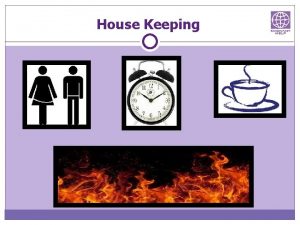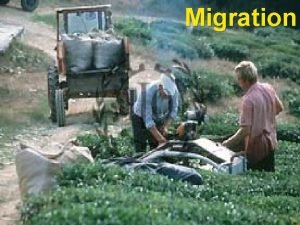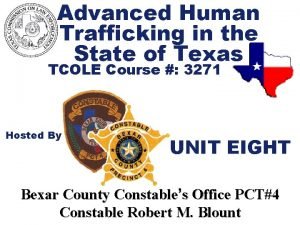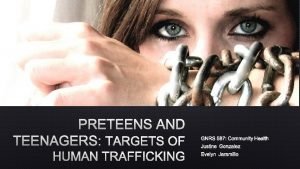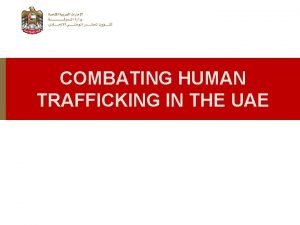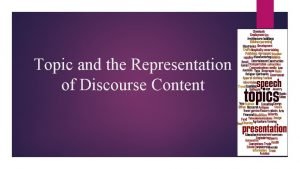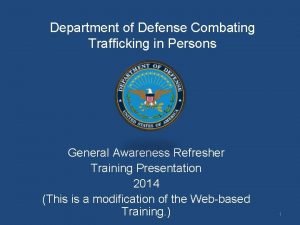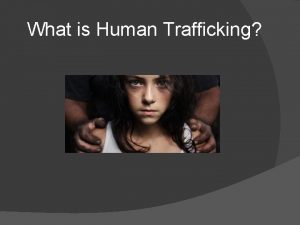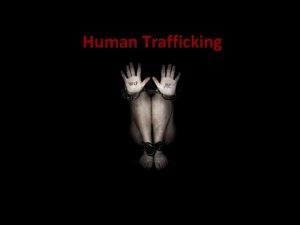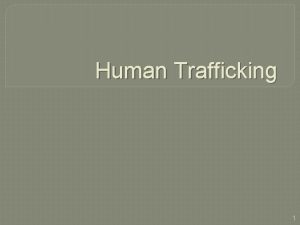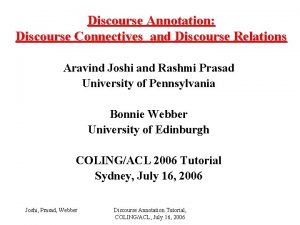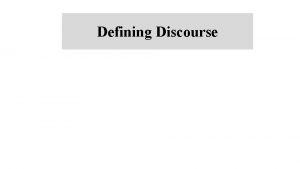Media Representation and Human Trafficking How AntiTrafficking Discourse













- Slides: 13

Media Representation and Human Trafficking: How Anti-Trafficking Discourse Affects Trafficked Persons 2 nd Annual Interdisciplinary Conference on Human Trafficking Oct. 2, 2010 Caroline S. Wallinger Arizona State University

Purpose of research: Identify competing representations of human trafficking in the U. S. Media and within advocacy networks Highlight common misrepresentations/oversimplifications regarding trafficking that appear in the media Examine the effects that such misrepresentations have for trafficked persons (services available, focus of legislation, social visibility, stigma, etc. ) Discuss alternatives/improvements to current representations that might provide a clearer and more accurate portrait of human trafficking and less damaging coverage for survivors of trafficking

Methodology q Content Analysis q Discourse Analysis q Contemporary Agenda Setting Theory (Maxwell Mc. Combs & Donald Shaw, 1972) q Michel Foucault – Archaeology of Knowledge/The Discourse on Language

What’s wrong with this picture?

“We must conceive discourse as a violence we do to things. ” - Michel Foucault

What is Human Trafficking? q. Prostitution? q. Child Soldiers? q. Forced Farm Labor? q. Garment Sweatshops? q. Domestic Servitude? q. Child Pornography? q. Organ Trade?

FORCE F R A U D Photos credits: The New York Times (Robert Gailbraith), the Coalition of Immokalee Workers, Free the Slaves, the United Nations Human. Trafficking. org COERCION

Trafficking in the Media q Craigslist Says It Has Shut Down Its Section for Sex Ads q Man who authorities believe was running teen prostitution ring arrested after chase q Trafficking in humans: The proposed Alien Smuggling and Terrorism Prevention Act would put some much needed teeth into laws aimed at stopping those who smuggle people into the U. S. q Teen victim of suspected pimp missing in So. Cal q 14 illegal immigrants found in a Reseda house q Prostitution Raids Rescue 52 Youths; Federal Officials Arrest Almost 700 People q North Dakota: Immigrants Arrested q 3 Americans Face Child Sex Charges

Agenda Setting Theory Mc. Combs & Shaw: There is a strong correlation between media and voter emphasis on issues during political elections Media focus on a small number of issues over time. Public interest in issues increases as coverage increases. The way that the media covers an issue affects the way that the public thinks about that issue The organization of news around specific beats creates a bureaucratic infrastructure that amplifies the message for governmental and institutional sources. This is especially true for social justice issues that people would not know much about if they didn’t have access to news. “It is not the event which is reported that determines the form, content, meaning or `truth’ of the news, but rather the news that determines what it is that the event means” John Hartley, 1982

Key Findings Media Coverage Is: � � � The dominant paradigm “emphasizes sex trafficking over other forms of labor. . . [and] detrimentally impact[s] the lives of trafficked persons” Grace Chang and Kathleen Kim, 2007 “Media tend to write about the human trafficking issue with frames that do not fully communicate the scope and severity of the problem or its relevance to the American people. ” Marci Mc. Coy Roth, 2004 In the absence of an informed and mobilized public, resources for fighting human trafficking as a whole become limited, and subjects of trafficking have less hope for escaping the oppressive systems that place them at risk of exploitation. Oversimplified Prostitution Immigration Organized Crime Incident Reactionary News agencies tend to report on isolated events Not very many in-depth analyses Race/Class/Gender issues Not much discussion of trafficking overseas Reinforcement of common (often incorrect) stereotypes

Thank You! Carrie Wallinger cswallinger@gmail. com

References Photo Credits: � International Organization for Migration (IOM). 2007. Don't Be Afraid to Say It for Her! Together Against Human Trafficking. http: //www. reknito. cz/index. php? PHPSESSID=13288 b 583 d 82049 f 1 a 192 af 9 b 4 f 44 e 0 a. Headline Credits: � � � � Anon. 2009. Trafficking in Humans: The Proposed Alien Smuggling and Terrorism Prevention Act Would Put Some Much-Needed Teeth into Laws Aimed at Stopping Those Who Smuggle People into the U. S. Los Angeles Times, April 25. Opinion. http: //articles. latimes. com/2009/apr/25/opinion/ed-trafficking 25. Cart, Julie. 2010. Man Who Authorities Believe Was Running Teen Prostitution Ring Arrested After Chase. Los Angeles Times. L. A. Now. September 30. http: //latimesblogs. latimes. com/lanow/2010/09/prostitution-teenrunaway-human-trafficking-missing-. html. Markman, Joe. 2009. Prostitution Raids Rescue 52 Youths; Federal Officials Arrest Almost 700 People, Including 60 Suspected Pimps, in a Three-Day Nationwide Crackdown. Los Angeles Times, October 26, Home Edition, Sec. A. Mc. Donnell, Patrick J. 2010. 14 Illegal Immigrants Found in Reseda House; They Were Being Held Against Their Will, Officials Say. Two More Were Found Nearby. Los Angeles Times, February 2, Home Edition, Sec. AA. Miller, Claire Cain. 2010. Craigslist Says It Has Shut Its Section for Sex Ads. The New York Times, September 15, New York edition, Business. Preston, Julia. 2008. North Dakota: Immigrants Arrested. The New York Times, October 30, Late Edition, Sec. A. Surdin, Ashley. 2009. 3 Americans Face Child-Sex Charges; Men Arrested in Cambodia are the First Prosecuted Under Trafficking Initiative. The Washington Post, September 1, Suburban Edition, Sec. A. The Associated Press. 2010. Teen Victim of Suspected Pimp Missing in Socal. Mercury. News. com, September 30, e. Edition. http: //www. mercurynews. com/breaking-news/ci_16214236.

References Bales, Kevin. 1999. Disposable People: New Slavery in the Global Economy. Berkeley, CA: Univ. of California Press. � Chang, G. , and K. Kim. 2007. Reconceptualizing Approaches to Human Trafficking: New Directions and Perspectives from the Field(s). Stanford Journal of Civil Rights and Civil Liberties 3: 317. � Fishman, Mark. 1997. News and Nonevents: Making the Visible Invisible. In Social Meanings of News: A Text Reader, ed. Dan Berkowitz, 210 -229. Thousand Oaks, CA: Sage Publications. � � � � Foucault, Michel. 1972 a. The Discourse on Language. In The Archaeology of Knowledge, 215237. New York: Pantheon Books. ———. 1972 b. The Archaeology of Knowledge. New York: Pantheon Books. Hartley, John. 1982. Understanding News. London and New York: Methuen. Jahic, Galma, and James O. Finckenauer. 2005. Representations and Misrepresentations of Human Trafficking. Trends in Organized Crime 8, no. 3: 24 -40. Kempadoo, Kamala, ed. 2005. Trafficking and Prostitution Reconsidered: New Perspectives on Migration, Sex Work, and Human Rights. Boulder, CO: Paradigm Publishers. Mc. Combs, Maxwell E. , and Donald L. Shaw. 1972. The Agenda-Setting Function of Mass Media. Public Opinion Quarterly 36, no. 2: 176 -187. Roth, Marci Mc. Coy. 2004. How Social Injustices Fail to Reach the Public Agenda: A Case Study of Human Trafficking. Conference Papers -- American Political Science Association: 120.
 Aims and objectives of human trafficking
Aims and objectives of human trafficking Advanced human trafficking #3271 test answers
Advanced human trafficking #3271 test answers Human trafficking grooming
Human trafficking grooming Human trafficking map
Human trafficking map 3271 advanced human trafficking
3271 advanced human trafficking Human trafficking
Human trafficking Human trafficking definition
Human trafficking definition Human trafficking
Human trafficking Combating human trafficking in the uae
Combating human trafficking in the uae 3271 advanced human trafficking
3271 advanced human trafficking Discourse analysis in linguistics
Discourse analysis in linguistics Topic and the representation of discourse content
Topic and the representation of discourse content Ctip clause that must be included in every contract
Ctip clause that must be included in every contract What is trafficking in persons
What is trafficking in persons
